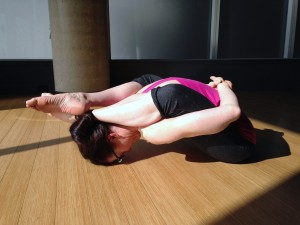Hypermobility -what does it mean, in simple terms?
Remember being at school… there were always people who were “double jointed”. Those whose party trick involved joints that did some really weird stuff. Maybe you were one of those.
I was (and still am) the complete opposite. My trick was NOT being able to touch my toes.
Hypermobility, fun as it is when you’re a kid, has a few things that can catch up with you in later life. If you are the kind of person that can (or could, as a child) easily touch the floor with both hands, have bendy elbows and knees, double jointed thumbs and stretchy skin, you might want to read on a little further…

The greater range of movement enjoyed by the Hypermobile comes from laxity in the Ligaments and Joint capsules. These are the things that stop joints dislocating. (Generally its a genetic thing to do with collagen as to how much flexibility you have in them).
Ligaments limit range of movement, but prior to relying on ligaments we have muscles that kick in to control that movement. Some people lack muscle strength or proprioception (recognition of where a limb is in space – regulated by receptors in soft tissue) and so have less control over the joint. This can mean a greater risk of sprains, dislocations and also of general joint pain through reliance on ligaments rather than muscles to control joints at end of range.
This lack of muscular joint sense and control tends to be widespread among the hypermobile community.
Later in life, Hypermobile people tend to shy away from sport, if only because of previous dislocations and injuries. Impacts, balls, lack of co-ordination and joints that dislocate easily mean that sports and hypermobility do not necessarily mix well.
Yoga, however, may appear to be the perfect thing. Its easy for the bendy person, non-impact, and they rapidly appear to be very good at it. (And we all like to be good at something).
The problem is, the better you get at it, the more the ligaments and joint capsules get stretched, and the less stable the joints become.
(Note…. yes I know there is some level of muscular recruitment involved, but the problem is joint articulation flexibility beyond the norm, not control through the normal range).
Conversely, people like me who have ligaments apparently made of old boots find yoga very hard to do, and avoid it, whereas in fact it should be me doing yoga, and the hyperflexible people should be lifting weights.
What? Why?!
Let’s get one thing clear:
Flexibility is not bad.
Hyperflexibility is not necessarily bad either.
Uncontrolled hyperflexibility… now that can be a problem.
We see people with a history of hyperflexibility who have various joint pains and other issues involving pain and age related changes – these appear to stem from a lack of joint control which has become worse as their muscular development and control has reduced throughout their life.
Now, I must hasten to add the problems do NOT occur simply because they are hypermobile.
I would suggest it is because they are unable to control this hypermobility.
We know you cannot train ligaments and capsules to be shorter or more stable. It doesn’t work like that. The only way to sort those out is with surgery, and that isn’t necessarily a good idea. What you CAN do is train the things that control movement – the muscles. You can strengthen them, you can gain more control with them and you can use them to control your body. What is great about this is you can do it at any time of life as well.
Just because someone once looked at your flexible or lax joints and said “ooooh, you’ll have trouble with them later in life” simply points to their lack of understanding, it does not mean that you can’t take control of your condition.
 I’m not going to say that there is a magic bullet. I’m certainly not going to say that it’s an easy journey – nothing worth doing is, and I’m definitely not going to say that it will be simple. That just is not the case.
I’m not going to say that there is a magic bullet. I’m certainly not going to say that it’s an easy journey – nothing worth doing is, and I’m definitely not going to say that it will be simple. That just is not the case.
However, there is something that can be done.
Simply speaking, it is about moving more, being more aware of your body, and recognising certain things that (for the moment) it’s best avoiding. Wandering around hoping it will go away will not work. Stretching more and more also will not work. If you have issues with excessive flexibility, you do NOT need to stretch more even if you feel “stiff” – (which is a common aspect of being hyperflexible).
Control, stability and strength are the key things that you need to think about and act upon.
If you’re in the area and are concerned about your hypermobility, give us a shout – its good to talk.




